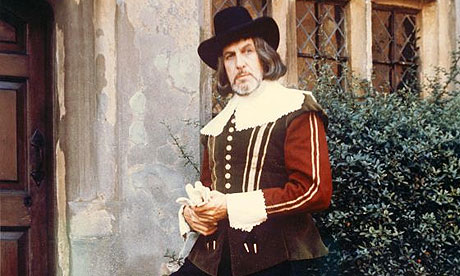Peter Bogdanovich’s Targets (1968)
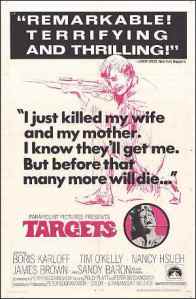
USA, 1968 Dir: Peter Bogdanovich
Starring Boris Karloff, Tim O’Kelly, Peter Bogdanovich, Athur Peterson, Monte Landis, Nancy Hsueh
Targets opens as a Gothic horror, like any of a dozen Roger Corman B-movies, with Boris Karloff stalking around his 19th century mansion. Then the lights come up and Karloff is seen watching the film with studio executives. Playing a version of himself, under the rather obvious but amusing moniker of Byron Orlok, Karloff is the ageing horror star who decides to call it a day, stating “I’m an antique, out of date … an anachronism. The world belongs to the young. Make way for them, let them have it.” Immediately after these words, the film cuts to Karloff as seen through the lens of a rifle. Young Bobby (Tim O’Kelly) has just made an easy purchase of a new rifle and ammunition using his dad’s chequebook. Within the first few minutes, the film’s intentions are clear – it’s ring out the old, bring in the new in terms of horror.
Targets came about through a strange set of circumstances, when B-movie maestro Roger Corman realised that Boris Karloff owed him three days filming. With the proviso that sequences from one of his previous Gothic horrors must be incorporated, Corman gave film critic and aspiring filmmaker Peter Bogdanovich the chance to direct his first feature using the old footage and three days with Karloff. The obvious conclusion that Bogdanovich would simply make a creaky old B-movie were dispelled when the young director instead created something daringly new out of the necessary elements. Simultaneously a celebration of the classic Gothic style which had dominated Hollywood since the 1930’s and a critique of the old methods in the face of very real terrors that existed in 1960’s (and modern day) America, Targets is a brave piece of mainstream cinema. Rather than sit amongst the traditional American horror films of the 1960’s, Targets has more in common with the challenging works of the American New Wave instigated with Bonnie And Clyde in 1967. Indeed, Bogdanovich would go on to become a key figure in the first flourish of this New Hollywood, alongside Robert Altman, Mike Nichols, Sam Peckinpah and Arthur Penn, and Targets can be seen as one of the first attempts to present modern-day violence with an appropriate level of seriousness.
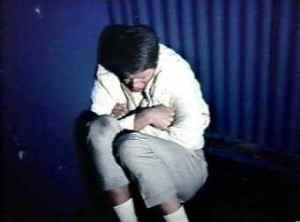 The two narrative strands of the retiring Karloff and the disturbed Bobby interweave with each other throughout, until they finally merge in the closing sequence. The scenes with Karloff are poignant and warm, whilst the scenes with Bobby are chilling and cold, with Bogdanovich using an effective colour scheme to express the mood of the contrasting narratives. Karloff’s scenes are bathed in yellows and browns, like autumn years viewed through a whisky glass, conveying a cosy warmth befitting the story of the “antique” actor recalling his old-fashioned movies. Conversely, Bobby’s scenes are filled with blues and whites, making them feel sterile and unemotional, befitting the story of a cold-blooded murderer disconnected from the world around him. Although coldly stylized, the stark reality and matter-of-fact presentation of Bobby’s murders are incredibly frightening. Unlike the rousing music and stock effects which accompany the Gothic opening, Bobby’s attacks are presented in their authentic sound-scape, mostly silences punctuated by loud gun shots. The sequence of Bobby killing his family and calmly putting their bodies to bed is all the more terrifying for it’s domestic setting and non-sensational approach. This really was a new direction for the horror genre, chilling in a different way even to the contemporary horrors of Hitchcock’s Psycho (1960), because the Bates motel actually feels very much in the Gothic mould. Targets horrors are all too real, occurring in undimmed daylight. All the more alarming though – Bobby is a charming, well-mannered young man who commits his crimes as if they were a natural extension of his everyday life. “Hardly ever missed, did I?” he happily boasts after a spate of shootings.
The two narrative strands of the retiring Karloff and the disturbed Bobby interweave with each other throughout, until they finally merge in the closing sequence. The scenes with Karloff are poignant and warm, whilst the scenes with Bobby are chilling and cold, with Bogdanovich using an effective colour scheme to express the mood of the contrasting narratives. Karloff’s scenes are bathed in yellows and browns, like autumn years viewed through a whisky glass, conveying a cosy warmth befitting the story of the “antique” actor recalling his old-fashioned movies. Conversely, Bobby’s scenes are filled with blues and whites, making them feel sterile and unemotional, befitting the story of a cold-blooded murderer disconnected from the world around him. Although coldly stylized, the stark reality and matter-of-fact presentation of Bobby’s murders are incredibly frightening. Unlike the rousing music and stock effects which accompany the Gothic opening, Bobby’s attacks are presented in their authentic sound-scape, mostly silences punctuated by loud gun shots. The sequence of Bobby killing his family and calmly putting their bodies to bed is all the more terrifying for it’s domestic setting and non-sensational approach. This really was a new direction for the horror genre, chilling in a different way even to the contemporary horrors of Hitchcock’s Psycho (1960), because the Bates motel actually feels very much in the Gothic mould. Targets horrors are all too real, occurring in undimmed daylight. All the more alarming though – Bobby is a charming, well-mannered young man who commits his crimes as if they were a natural extension of his everyday life. “Hardly ever missed, did I?” he happily boasts after a spate of shootings.
The film’s final sequence has a riveting premise as Bobby shoots through a hole in the screen into the audience of a drive-in, the victims unable to see him but are themselves visible from the light of the film. The melodramatic soundtrack of the drive-in movie (the same Gothic horror from the opening scene) heard through the cinema’s speakers whilst Bobby picks off members of the audience seems sickeningly inappropriate, yet reveals the pertinent truth that certain things are just too horrific to suit the manner of sensationalism. Karloff’s concluding words “is that what I was afraid of?” speaks volumes about the stripped-down reality of horror films with a contemporary setting. No dressing up of large sets, no monstrous make-up, no strikes of lightning – just a boy with a rifle.
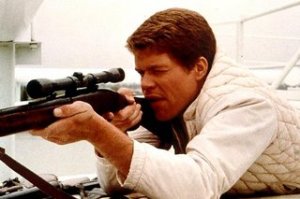 What is most striking about Targets is how incredibly assured it is with it’s own knowing deconstruction of cinema. Bogdanovich even plays a version of himself called Sammy (named after writer-director Samuel Fuller, who advised on the film) who is trying to prepare a new horror film that will show Orlock in a different light, as indeed this film allows Karloff’s acting to shine in a role of rare sincere depth (it’s a wonderful performance from the veteran in one of his last films before his death in 1969). This film has as much to say about the art of filmmaking as it does about contemporary violence in the USA. For a low-budget picture from a first-time director, Targets is a brilliantly confident and detailed film, but it had little effect in 1968, proving unpopular with audiences after the recent assassinations of Martin Luther King and Robert F. Kennedy. It’s only important effect was securing Bogdanovich good notices, leading him on to greater heights of success in the 1970’s. But 40 years on, Targets can be seen as remarkably portentous in the way that it literally passes the baton between the old (the Corman Gothic cycle) and the new (gritty thrillers and slasher movies of the 1970’s). It is equally effective as both a horror-thriller and as a critique of the gun laws in the USA, arguing that the real threat could well exist in your own home, as opposed to those of a 19th century mansion. Both can be scary, but Targets ensures that contemporary home-grown terrors are the more disturbing.
What is most striking about Targets is how incredibly assured it is with it’s own knowing deconstruction of cinema. Bogdanovich even plays a version of himself called Sammy (named after writer-director Samuel Fuller, who advised on the film) who is trying to prepare a new horror film that will show Orlock in a different light, as indeed this film allows Karloff’s acting to shine in a role of rare sincere depth (it’s a wonderful performance from the veteran in one of his last films before his death in 1969). This film has as much to say about the art of filmmaking as it does about contemporary violence in the USA. For a low-budget picture from a first-time director, Targets is a brilliantly confident and detailed film, but it had little effect in 1968, proving unpopular with audiences after the recent assassinations of Martin Luther King and Robert F. Kennedy. It’s only important effect was securing Bogdanovich good notices, leading him on to greater heights of success in the 1970’s. But 40 years on, Targets can be seen as remarkably portentous in the way that it literally passes the baton between the old (the Corman Gothic cycle) and the new (gritty thrillers and slasher movies of the 1970’s). It is equally effective as both a horror-thriller and as a critique of the gun laws in the USA, arguing that the real threat could well exist in your own home, as opposed to those of a 19th century mansion. Both can be scary, but Targets ensures that contemporary home-grown terrors are the more disturbing.
La Nouvelle Vague à Cinquante! – Celebrating The French New Wave

This year marks the 50th anniversary of the start of La Nouvelle Vague, the French New Wave which transformed and dominated European cinema in the late 1950’s and 1960’s. Although the majority of French films from this decade are blanketed with the term Nouvelle Vague, the movement encompassed many different styles and approaches to cinema from a wide variety of directors. The New Wave filmmakers were all united by their desire to alter the horizons of cinema, rejecting the formalist traditions of the classical style, although they never formally recognised themselves as being part of one conscious group, more a body of young filmmakers sharing the same iconoclastic mindset. However, despite their wish to rewrite the cinematic rulebook, many of the directors had a great appreciation for classical cinema. In fact, the movement’s origins began with the magazine Cahiers du Cinema, which saw critics and future pioneering directors Francois Truffaut, Eric Rohmer, Jean-Luc Godard, Claude Chabrol and Jacques Rivette create anew the doctrine of film theory and criticism. Under the guidance of Cahiers founder Andre Bazin, the critics were instrumental in re-evaluating the importance of classical films both in France (from Renoir, Vigo and Cocteau) and in Hollywood. The Cahiers writers felt that the artistic achievements of certain Hollywood directors were undervalued, as they had always been associated with the restrictive American studio production line. Through these writings, the manifesto for ‘Les Politiques des Auteurs’ emerged, where the critics argued that the stylistic approaches and use of mise-en-scene gave some films greater merit beyond their generic narratives. These theories greatly enhanced the critical value of Hollywood director’s oeuvres, notably Nicholas Ray, John Ford, Orson Welles, Howard Hawks and Alfred Hitchcock. Francois Truffaut even conducted lengthy interviews with Hitchcock for a book published in 1967. The Cahiers critics were really the first to celebrate the American films of the 1940’s and 1950’s that are now regarded as classics.
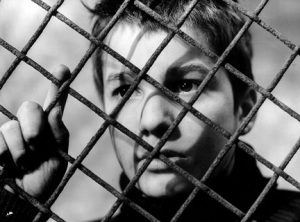 To represent the varied approaches within the Nouvelle Vague, I’ve chosen to briefly discuss four of my favourite films from the movement, all of which represent very different interpretations of the wave’s intentions from four key directors. The 400 Blows (1959) is generally considered the first film of the wave. Directed by Francois Truffaut, it tells the story of troubled teenager Antoine Doinel, as he struggles at home and at school, finally being sent to a detention camp after being misunderstood by his parents and the authorities as an incorrigible trouble maker. The film gives a bleak, realistic presentation of events, an influence from Robert Bresson and also the Italian neo-realist style, but combines it with playful cinematic techniques including jump cuts and freeze frames. In the final sequence, the camera tracks Antoine running along the beach towards the ocean for the first time in his life, followed by a zoom in and a sudden freeze frame, as Antione apparently stares at the audience. It’s undoubtedly one of the most memorable and powerful moments in cinema history. The 400 Blows clearly expresses the New Wave’s unwritten manifesto of rejecting traditionally structured linear narrative, instead presenting an episodic account more interested in the experiences of the character, as well as the film’s stunning black and white photography. This film would become the first episode in an unprecedented twenty-year series of four films and one short, showing the young Antoine (always played by Jean-Pierre Leaud) become an adult, fall in love and start a family in Antoine And Colette (1962), Stolen Kisses (1968), Bed And Board (1970) and Love On The Run (1979). A similar romantic story with dark realistic overtones was Truffaut’s 1962 masterpiece Jules et Jim, which gave Truffaut even greater scope for innovative techniques. Similarly, Godard’s Bande A Part (1964) explored a dangerous love triangle with playful exuberance, whilst Jacques Remy’s The Umbrellas Of Cherbourg (1964) presented a romantic liaison as a musical in glorious technicolour, giving Catherine Deneuve her breakthrough role.
To represent the varied approaches within the Nouvelle Vague, I’ve chosen to briefly discuss four of my favourite films from the movement, all of which represent very different interpretations of the wave’s intentions from four key directors. The 400 Blows (1959) is generally considered the first film of the wave. Directed by Francois Truffaut, it tells the story of troubled teenager Antoine Doinel, as he struggles at home and at school, finally being sent to a detention camp after being misunderstood by his parents and the authorities as an incorrigible trouble maker. The film gives a bleak, realistic presentation of events, an influence from Robert Bresson and also the Italian neo-realist style, but combines it with playful cinematic techniques including jump cuts and freeze frames. In the final sequence, the camera tracks Antoine running along the beach towards the ocean for the first time in his life, followed by a zoom in and a sudden freeze frame, as Antione apparently stares at the audience. It’s undoubtedly one of the most memorable and powerful moments in cinema history. The 400 Blows clearly expresses the New Wave’s unwritten manifesto of rejecting traditionally structured linear narrative, instead presenting an episodic account more interested in the experiences of the character, as well as the film’s stunning black and white photography. This film would become the first episode in an unprecedented twenty-year series of four films and one short, showing the young Antoine (always played by Jean-Pierre Leaud) become an adult, fall in love and start a family in Antoine And Colette (1962), Stolen Kisses (1968), Bed And Board (1970) and Love On The Run (1979). A similar romantic story with dark realistic overtones was Truffaut’s 1962 masterpiece Jules et Jim, which gave Truffaut even greater scope for innovative techniques. Similarly, Godard’s Bande A Part (1964) explored a dangerous love triangle with playful exuberance, whilst Jacques Remy’s The Umbrellas Of Cherbourg (1964) presented a romantic liaison as a musical in glorious technicolour, giving Catherine Deneuve her breakthrough role.
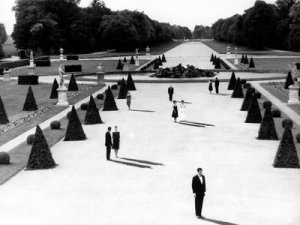
Alain Resnais’ Last Year At Marienbad (1961) is a film rich with symbolism and vague meaning. Having previously been revered for his acclaimed dramatic-documentary Hiroshima Mon Amour (1959), Resnais collaborated with writer Alain Robbe-Grillet (later another New Wave director) on his first fictional narrative feature, although the shifting perspectives of Marienbad would make it far removed from other narrative films in the movement. Whilst Truffaut, Godard and Chabrol represented the Cahiers directors, Resnais represented the Rive Gauche or ‘Left Bank’ filmmakers, alongside Chris Marker, Anges Varda and Robbe-Grillet. These distinctively bohemian directors took the approaches of the New Wave to more experimental levels. Resnais imbues Marienbad with a subtle sense of strangeness – in the vivid scenes of the chateau’s garden (pictured), the people walking cast long dark shadows, whilst the numerous pointed trees cast no shadow at all. The film abandons plot and narrative in favour of images, events and the sense of characters caught in a dream-like state of repeated memory. Unsurprisingly, the film divided critics, who either saw it as a beautiful masterpiece or a bewildering exercise in self-indulgence. In truth, Last Year At Marienbad is a hypnotic combination of both these things – it is at once beautiful and bewildering, but I don’t really believe it’s worth analysis beyond mentioning it’s powerfully arresting visuals. The film is an open-book for interpretive meanings and debates, which can be enjoyed as much as it can be alienating. However, it is the major film of the New Wave to fully embrace the movement’s art house leanings, an approach taken to even bolder experimentation in Jacques Rivette’s Celine And Julie Go Boating (1974).
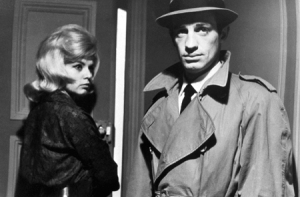
Le Doulos (1962), directed by Jean-Pierre Melville, is a stylish gangster movie featuring many plot twists involving theft, murder and deception. Given the Nouvelle Vague touch, this crime thriller takes on an almost surreal aesthetic, artistically exaggerating the chiaroscuro technique associated with film noir. The hyper-reality of the world created by Melville has characters wearing strikingly overstated trench coats, shot in extreme contrasting shadows. Jean-Pierre Melville became a major figure of the New Wave, although he had been directing feature films since 1949, making him a continually strong presence in French cinema who, along with Robert Bresson, bridged the gap between the classical era and the Nouvelle Vague. Influenced by American crime movies, Melville’s noir-style thrillers were hugely influential to other New Wave directors – his 1956 film Bob La Flambeur being the first of it’s kind in France. Truffaut’s second feature, Shoot The Piano Player (1960) owed it an obvious debt, as did Godard’s pulp sci-fi classic Alphaville (1965). These classy thrillers suited the fashionable groove of the sixties and Melville became the most important exponent of the policier genre – gangster films taking their lead from American film noirs but offering a uniquely French perspective. This particular sub-genre reached it’s zenith with Melville’s own The Godson (1967) and The Red Circle (1970). Hip and referential, much of the flashy style of these noir movies had been previously explored in Godard’s seminal Nouvelle Vague masterpiece Breathless (1960), the second film from the Wave. A significant stylistic strand throughout the wave, one of the movement’s final great crime thrillers was Charles Chabrol’s The Butcher in 1970. The French noir really is the ultra-cool division of the Nouvelle Vague.
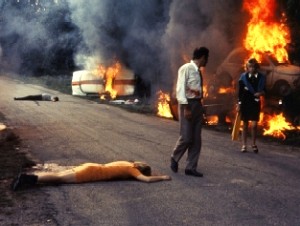 Weekend (1967), Jean-Luc Godard’s darkest film is a strikingly ambitious black satire on French bourgeois society and moves from the bickering of a middle-class couple and some aggressive road rage through to revolution, violent murder and cannibalism. It’s surrealistic approach and fierce attacks on the complacent middle classes make it comparable to the work of Luis Bunuel, who was also making films in France during this period (the similarly daring Belle de Jour was released the same year). Viscous and shocking in it’s approach, Weekend takes the Nouvelle Vague’s reactionary course to the ultimate extreme, incorporating moments of Brechtian disillusion and scenes of pure fantasy (Lewis Carroll and Emily Bronte wandering in the woods springs to mind!). Admittedly the film is a pretty hard watch and frustratingly incomprehensible in parts (although not nearly as baffling as Godard’s rockumentary-come-political manifesto Sympathy For The Devil in 1968), but that’s really the point – there’s something fantastically daring and exhaustively rewarding about Weekend. For its famous and breathtaking ten-minute tracking shot of an ever-worsening traffic jam alone, the film is a landmark in black comedy. Allowing itself to be completely free of any strictures, the film remains one of the most relentlessly wild and inventive additions to the French New Wave. Weekend ends with two captions – ‘End Of Film’ and ‘End Of Cinema’ – not only pointing to the total collapse of civilisation within the film’s narrative but perhaps acknowledging that Godard had taken the New Wave as far as it could possible go.
Weekend (1967), Jean-Luc Godard’s darkest film is a strikingly ambitious black satire on French bourgeois society and moves from the bickering of a middle-class couple and some aggressive road rage through to revolution, violent murder and cannibalism. It’s surrealistic approach and fierce attacks on the complacent middle classes make it comparable to the work of Luis Bunuel, who was also making films in France during this period (the similarly daring Belle de Jour was released the same year). Viscous and shocking in it’s approach, Weekend takes the Nouvelle Vague’s reactionary course to the ultimate extreme, incorporating moments of Brechtian disillusion and scenes of pure fantasy (Lewis Carroll and Emily Bronte wandering in the woods springs to mind!). Admittedly the film is a pretty hard watch and frustratingly incomprehensible in parts (although not nearly as baffling as Godard’s rockumentary-come-political manifesto Sympathy For The Devil in 1968), but that’s really the point – there’s something fantastically daring and exhaustively rewarding about Weekend. For its famous and breathtaking ten-minute tracking shot of an ever-worsening traffic jam alone, the film is a landmark in black comedy. Allowing itself to be completely free of any strictures, the film remains one of the most relentlessly wild and inventive additions to the French New Wave. Weekend ends with two captions – ‘End Of Film’ and ‘End Of Cinema’ – not only pointing to the total collapse of civilisation within the film’s narrative but perhaps acknowledging that Godard had taken the New Wave as far as it could possible go.
The 1960’s was a decade of many shifts and surprises in culture and accordingly many new waves in cinema – in Italy, Britain, Japan, Czechoslovakia – but the most revolutionary and influential was surely the French New Wave, which gave the world many of the greatest films ever made. Bernando Bertolucci’s The Dreamers (2003) paid explicit tribute to the films of Godard and Truffaut, and the influence of the Nouvelle Vague can still be felt today in the films of Luc Besson, Jean-Pierre Jeunet and Michel Gondry.
The BFI French New Wave Season begins in April, showcasing a number of films from the movement, including The 400 Blows and Breathless, in London and around the country.
Recommended reading: A History Of The French New Wave Cinema by Richard John Neupert; Everything Is Cinema: The Working Life Of Jean-Luc Godard by Richard Brody; Francois Truffaut: The Complete Films by Robert Ingram.
Jerzy Skolimowski’s Deep End (1970)
 West Germany/GB, 1970 Dir: Jerzy Skolimowski
West Germany/GB, 1970 Dir: Jerzy Skolimowski
Starring Jane Asher, John Moulder-Brown, Diana Dors, Karl Michael Volger, Christopher Sandford
“If you can’t have the real thing – you do all kinds of unreal things.” Deep End kicks straight in with a splash of darkest red paint (or is it blood?) hitting the screen to the sound of Cat Stevens’ But I Might Die Tonight, from which point the film takes it’s hold and doesn’t let go for 90 minutes. The sordid and unglamourous view of a London bathhouse in the 1970’s could only have been the product of a foreign filmmaker. Polish director Jerzy Skolimowski’s outsider view perhaps reveals more about the quirks and vices of our nation than a homegrown talent could, ranking alongside Polanski’s Repulsion (1965) and Antonioni’s Blow-Up (1966) as uniquely skewed depictions of ‘swinging’ London. Deep End was a co-production between Britain and West Germany and was filmed in both countries, the mix of English actors and peculiarly dubbed German actors adding a bizarre tone to the film’s already-bewitching style.
The plot concerns 15-year old Mike (John Moulder-Brown) taking his first job in a public bathhouse, once a proud monument to Victorian respectability but now mostly a haven for unsavoury characters and their sexual urges. So, maybe not the best place for the naive and idealistic Mike to get his baptism of fire, surrounded by mature lady clients looking for their sexual kicks, various depraved middle-aged men and a scarily perverse swimming instructor.  Amidst this bubbling decadence, Mike’s attentions turn to his colleague, the provocative and beautiful Susan (Jane Asher), who soon becomes the focus of his dangerously obsessive adolescent fantasies. Asher’s Susan is no shrinking violet however, being manipulative and impulsively cruel almost on a whim – it’s a fascinating performance. The way she toys with Mike’s feelings, notably by seducing him in the cinema and then reporting him to the police for assault, reveal both her selfish and reckless streak. Moulder-Brown’s Mike is a captivating central character, not always likable but causing much empathy despite being frantically wayward, his soft plummy accent and sudden fits of rage raising the character above the usual coming-of-age teen. As the film swirls towards it’s shocking climax, the viewer is plunged deeper into the dark recesses of Mike’s ever more twisted psyche.
Amidst this bubbling decadence, Mike’s attentions turn to his colleague, the provocative and beautiful Susan (Jane Asher), who soon becomes the focus of his dangerously obsessive adolescent fantasies. Asher’s Susan is no shrinking violet however, being manipulative and impulsively cruel almost on a whim – it’s a fascinating performance. The way she toys with Mike’s feelings, notably by seducing him in the cinema and then reporting him to the police for assault, reveal both her selfish and reckless streak. Moulder-Brown’s Mike is a captivating central character, not always likable but causing much empathy despite being frantically wayward, his soft plummy accent and sudden fits of rage raising the character above the usual coming-of-age teen. As the film swirls towards it’s shocking climax, the viewer is plunged deeper into the dark recesses of Mike’s ever more twisted psyche.
The brilliant centrepiece of Deep End is an extended sequence set in and around the seedy clubs of Soho, as Mike embarks on a crazy nighttime odyssey into London’s weird underworld. The repeated encounters with the hot dog vender (played by Burt Kwouk and incidentally the only genuinely likeable character in the film) have been compared to Wong Kar Wai’s similarly ultra-real snack bar scenes in Chungking Express (1994). Mike stalks Susan in and out of clubs and backstreets, stumbles across a chatty prostitute with a broken leg, steals a life-size cardboard cut-out of Susan (or is it?) and buys hot dogs for a couple of Liverpudlian girls. But to describe it is to take away the spontaneous surrealism of the events. The whole sequence is set to the sound of Mother Sky by Krautrock pioneers CAN, a 14-minute blast of grimy pulsating bass rhythms, trippy guitars and hazy vocals. It’s no exaggeration to describe this as the most audaciously demented quarter of an hour ever put into a mainstream narrative film!
 Watching Deep End feels like you’ve somehow imagined it in a fevered dream, as if Mike’s confused desires spill out and effect the film’s aesthetic. The improvised quality of the performances and the blending of realist and surreal styles have the combined effect of a documentary as seen through an acid trip. The film lurches from absurd comedy (Diana Dors’ memorable scene as a sex-starved harridan; the out-of-control fire extinguisher) to startling symbolism (the ethereal underwater shots). In one scene, as passions increase in the bathhouse, a strange little man begins painting the wall dark red in the background, typical of the odd touches and vague symbolism that Skolimowski splatters throughout the film.
Watching Deep End feels like you’ve somehow imagined it in a fevered dream, as if Mike’s confused desires spill out and effect the film’s aesthetic. The improvised quality of the performances and the blending of realist and surreal styles have the combined effect of a documentary as seen through an acid trip. The film lurches from absurd comedy (Diana Dors’ memorable scene as a sex-starved harridan; the out-of-control fire extinguisher) to startling symbolism (the ethereal underwater shots). In one scene, as passions increase in the bathhouse, a strange little man begins painting the wall dark red in the background, typical of the odd touches and vague symbolism that Skolimowski splatters throughout the film.
Funny, tragic, disturbing and delirious, Deep End is a singular masterpiece which sits right at the top of my choice for the most underrated British film and, along with Ken Russell’s The Devils, from the same maverick era, the film most deserving an urgent DVD release. Until then, bootleg copies are doing the rounds and I strongly recommend you find one.
Update 20/01/10: New Information On Official Deep End DVD Release! http://tinyurl.com/ydvo77b
Hal Ashby’s Being There (1979)

USA, 1979 Dir: Hal Ashby
Starring Peter Sellers, Shirley Maclaine, Melvyn Douglas, Jack Warden, Richard A. Dysart, Richard Basehart.
This week sees the 30th anniversary DVD release of Hal Ashby’s comic fable Being There, the film which gave Peter Sellers his last great role. Sellers had become obsessed with Jerzy Kosinski’s novella Being There since the early 1970’s, fascinated by the character of Chance the Gardener, a man with hardly any personality but whom others see in him whatever character they want to see. Clearly tapping into Sellers’ anxiety of ‘who was the man behind the actor’s mask’ (he was famously quoted as saying “there used to be a me behind the mask, but I had it surgically removed”), the character of Chance represented the ultimate challenge for the actor. The story concerns the quiet and simple Chance, isolated from the world as a gardener in a private townhouse and learning all he needs to know through television, who through a chain of fortuity and misunderstanding becomes an important and influential figure in US high office, to the extent that his associates ultimately consider him as a Presidential candidate. Chance’s lack of personality and his short uncomplicated replies are seen by others as highly intelligent statements of great depth and profundity, essentially using Chance’s blank canvas to paint any picture they want on to it.
The film is deliberatley slow paced, befitting Chance’s measured nature, but there are several wonderful scenes throughout. As Chance first embarks on his lonely path back into society and towards his fate, we see him walking down the centre of a busy highway accompanied by a funk version of Also Sprach Zarathustra a la 2001: A Space Odyssey, highlighting the exploratory nature of this all-new territory. Later, when Shirley Maclaine’s sexually deprived Eve seduces Chance, she is unaware that he is entirely focused on watching television, resulting in one of the most bizarre sex scenes in cinema history! The film ends in the realms of the fantastic, with Chance apparently walking on water, raising questions as to whether his fated path was really so coincidental.
 Being There is surely the most gentle and thoughtful black satire ever made. Hal Ashby’s delicate direction is underrated, given that the film is generally regarded as a ‘Peter Sellers movie’, but afterall it was Sellers’ last film completed and released during his lifetime (his last film, released after his death, was a weak comedy of Fu Manchu, and the least said about the cobbled together Pink Panther sequels the better!). Sellers’ performance is understated and mesmeric (he said he had partly based his interpretation on the lackadaisical style of Stan Laurel) and netted him his first Oscar-nomination for Best Actor since Dr. Strangelove in 1964. Sadly he lost out to Dustin Hoffman in Kramer Vs. Kramer and to rub salt in the wounds his co-star Melvyn Douglas won the Best Supporting Actor Oscar. Sellers died from a heart attack on 24th July 1980, aged just 54. This delightful story of chance remains a fitting finale to a career encompassing many compelling and hilarious performances.
Being There is surely the most gentle and thoughtful black satire ever made. Hal Ashby’s delicate direction is underrated, given that the film is generally regarded as a ‘Peter Sellers movie’, but afterall it was Sellers’ last film completed and released during his lifetime (his last film, released after his death, was a weak comedy of Fu Manchu, and the least said about the cobbled together Pink Panther sequels the better!). Sellers’ performance is understated and mesmeric (he said he had partly based his interpretation on the lackadaisical style of Stan Laurel) and netted him his first Oscar-nomination for Best Actor since Dr. Strangelove in 1964. Sadly he lost out to Dustin Hoffman in Kramer Vs. Kramer and to rub salt in the wounds his co-star Melvyn Douglas won the Best Supporting Actor Oscar. Sellers died from a heart attack on 24th July 1980, aged just 54. This delightful story of chance remains a fitting finale to a career encompassing many compelling and hilarious performances.
Welles, Kurosawa and Polanski: Three Takes On Macbeth
I was lucky enough to see one of the first performances of Rupert Goold’s acclaimed staging of Macbeth at Chichester in 2007, starring Patrick Stewart and Kate Fleetwood, and was gripped by what I considered a very cinematic approach to theatre, re-imagining the play as a gory horror film set in the clinical hospitals and kitchens of Stalin’s Russia. Afterwards, buoyed with a new appreciation of the play, I was compelled to revisit the key film versions of Macbeth – three very different approaches, which individually display each director’s unique style.
 Orson Welles showed a repeated interest in the play, firstly staging an all-black 1936 stage production set in Haiti. His film of Macbeth (1948) was shot on a low budget in just 23 days, which Welles later admitted was a self-imposed limitation to see if “it might encourage other film-maker’s to tackle difficult subjects at greater speed”. The sets were made from papier-mache and take on an almost surreal grandeur. The lighting is dark and murky, creating a sense of heightened paranoia within the sparse, simple setting. The tone is really that of Macbeth-noir, unsurprising when it came off the back of Welles’ noir classics The Stranger (1945) and The Lady From Shanghai (1947), in many ways a perfect fit – Lady Macbeth’s ice-cool murderess is perfect film noir, as is Macbeth himself, the corrupt and fatally-flawed lead. The film was no exception to Welles’ continued battles with studio executives, who felt that the strong Scottish accents of the cast wouldn’t help the film commercially. The entire soundtrack was re-dubbed, whilst Welles left Hollywood for Europe, although he did later return at the studio’s request to cut 20 minutes from the film in 1950 and add a narration. Like many of his works, the version now available on DVD is restored to Welles’ original vision.
Orson Welles showed a repeated interest in the play, firstly staging an all-black 1936 stage production set in Haiti. His film of Macbeth (1948) was shot on a low budget in just 23 days, which Welles later admitted was a self-imposed limitation to see if “it might encourage other film-maker’s to tackle difficult subjects at greater speed”. The sets were made from papier-mache and take on an almost surreal grandeur. The lighting is dark and murky, creating a sense of heightened paranoia within the sparse, simple setting. The tone is really that of Macbeth-noir, unsurprising when it came off the back of Welles’ noir classics The Stranger (1945) and The Lady From Shanghai (1947), in many ways a perfect fit – Lady Macbeth’s ice-cool murderess is perfect film noir, as is Macbeth himself, the corrupt and fatally-flawed lead. The film was no exception to Welles’ continued battles with studio executives, who felt that the strong Scottish accents of the cast wouldn’t help the film commercially. The entire soundtrack was re-dubbed, whilst Welles left Hollywood for Europe, although he did later return at the studio’s request to cut 20 minutes from the film in 1950 and add a narration. Like many of his works, the version now available on DVD is restored to Welles’ original vision.
 Akira Kurosawa’s Throne Of Blood (1957) recasts Macbeth as a Samurai epic at the time of the feudal wars in medieval Japan. Like Kurosawa’s other historical films of the 1950’s, Rashomon (1950) and Seven Samurai (1954), this adaptation immerses itself in the natural elements. From the opening scenes of mist shrouding the barren countryside and the fierce winds, to the rain and lightning engulfing the woods, the natural world combines to control proceedings. Characters ride on horseback in and out of the mist as if guided to their ultimate doom by the elements, making the normally evil lead roles appear somewhat more sympathetic. The wood and castle are even given the name Cobweb, suggesting the duplicitous effect of the natural world, and at one point Toshiro Mifune’s Taketori (the Macbeth figure) even fires an arrow up towards the treacherous lightning in the sky. The scene of Taketori encountering the unearthly Spirit in the woods, the old woman bathed in a translucent glow and gently spinning cotton, is surely one of the most beautiful sequences in movie history. Throne Of Blood is an exceptional, visceral film, which perfectly utilizes Kurosawa’s talent for impressive battle scenes. The film concludes not with a duel but with the magnificent image of countless darting arrows pinning the tragic Taketori to the wall of his fortress, having been turned on by his own men. This famous sequence was reportedly filmed using real arrows in order to give Mifune the desired look of terror, although this has been disputed.
Akira Kurosawa’s Throne Of Blood (1957) recasts Macbeth as a Samurai epic at the time of the feudal wars in medieval Japan. Like Kurosawa’s other historical films of the 1950’s, Rashomon (1950) and Seven Samurai (1954), this adaptation immerses itself in the natural elements. From the opening scenes of mist shrouding the barren countryside and the fierce winds, to the rain and lightning engulfing the woods, the natural world combines to control proceedings. Characters ride on horseback in and out of the mist as if guided to their ultimate doom by the elements, making the normally evil lead roles appear somewhat more sympathetic. The wood and castle are even given the name Cobweb, suggesting the duplicitous effect of the natural world, and at one point Toshiro Mifune’s Taketori (the Macbeth figure) even fires an arrow up towards the treacherous lightning in the sky. The scene of Taketori encountering the unearthly Spirit in the woods, the old woman bathed in a translucent glow and gently spinning cotton, is surely one of the most beautiful sequences in movie history. Throne Of Blood is an exceptional, visceral film, which perfectly utilizes Kurosawa’s talent for impressive battle scenes. The film concludes not with a duel but with the magnificent image of countless darting arrows pinning the tragic Taketori to the wall of his fortress, having been turned on by his own men. This famous sequence was reportedly filmed using real arrows in order to give Mifune the desired look of terror, although this has been disputed.
Roman Polanski’s The Tragedy Of Macbeth (1971) was his first feature since the brutal murder of his wife Sharon Tate and their unborn child at the hands of the Manson family, leading many to view the film as a violent cathartic exercise from the grieving director. It’s certainly the most unflinchingly violent adaptation of the play, even depicting the murder of Duncan in all it’s gory detail for the first time on film, rather than off-stage as written. The slaying of the MacDuff family in particular is almost too brutal to watch, especially given its obvious comparisons with the Tate  murders. Certain scenes, such as the meeting with the witches and the apparition in the woods, dip the viewer into the terrifying world of the surreal, a dark hallmark of Polanski’s work as seen in Repulsion (1965), Rosemary’s Baby (1968) and The Tenant (1976). As well as the horrific style, Polanski took controversial liberties with the play by casting 26-year old Francesca Annis as a much tamer Lady Macbeth and giving her a notorious nude soliloquy (but not so strange when it was revealed the film was being partly funded by Playboy magazine, although Polanski and co-writer Kenneth Tynan maintained the scene was written before Hugh Hefner’s involvement). Jon Finch was also a comparatively young Macbeth at 29 years old. The film’s ending replaces Malcolm’s speech with a scene of Malcolm’s brother returning from exile with possible ambitions to reclaim the throne, suggesting that the evil in man is ever present – something Polanski had experienced all too graphically in the summer of 1969.
murders. Certain scenes, such as the meeting with the witches and the apparition in the woods, dip the viewer into the terrifying world of the surreal, a dark hallmark of Polanski’s work as seen in Repulsion (1965), Rosemary’s Baby (1968) and The Tenant (1976). As well as the horrific style, Polanski took controversial liberties with the play by casting 26-year old Francesca Annis as a much tamer Lady Macbeth and giving her a notorious nude soliloquy (but not so strange when it was revealed the film was being partly funded by Playboy magazine, although Polanski and co-writer Kenneth Tynan maintained the scene was written before Hugh Hefner’s involvement). Jon Finch was also a comparatively young Macbeth at 29 years old. The film’s ending replaces Malcolm’s speech with a scene of Malcolm’s brother returning from exile with possible ambitions to reclaim the throne, suggesting that the evil in man is ever present – something Polanski had experienced all too graphically in the summer of 1969.


